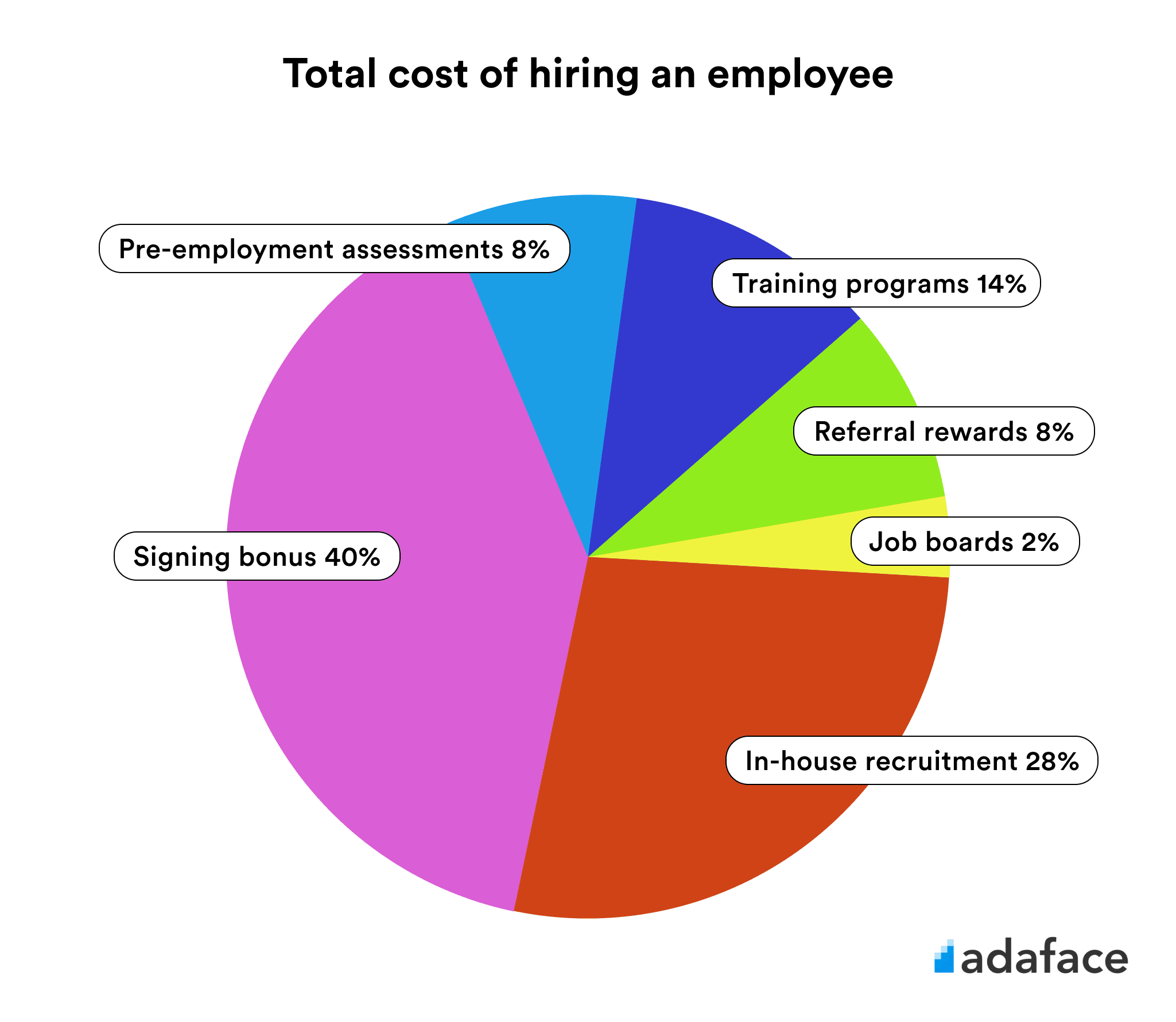

If you're a recruitment professional, you know that finding the right talent is priceless. But what about the cost of finding that talent?
Recruitment ROI might sound like a dry concept, but it's one of the most important metrics in HR and recruitment. In simple terms, recruitment ROI helps you determine whether the money you're spending on recruitment is worth it. And let's face it, who doesn't want to know whether they're getting their money's worth, right?
By calculating your recruitment ROI, you can determine how much you're spending on recruitment and compare it to the value you're getting from your new hires. This allows you to make informed decisions about your recruitment strategy and optimize your resources for the best results.
The cost of recruitment
Recruiting new talent is an important aspect of any business, but it can also be costly. When calculating the recruitment cost, there are internal and external factors to consider.
Internal costs: Include the time and resources spent by HR staff and hiring managers on the recruitment process and the cost of internal job postings or employee referral incentives. These costs can add up quickly, particularly if hiring takes longer than expected.
External costs: Include fees for job board postings, recruitment agencies, and background checks. These costs can vary widely depending on the source.

It's worth noting that the true cost of hiring a new employee goes beyond just the recruitment process. Once a new employee is hired, additional costs may be associated with onboarding, training, and benefits.
To get a better understanding of the whole picture, be sure to check out our blog post on the real cost of hiring a new employee.
Different metrics to be used to calculate ROI
ROI is an important metric for any business, as it helps to measure the return on investment for the money spent.
- Cost per hire (CPH): This metric measures the total cost of hiring a new employee, including recruitment advertising, agency fees, background checks, and other expenses. CPH can help companies to identify the most cost-effective recruitment methods.
- Time to fill (TTF): This metric measures the number of days between a job posting and a candidate's acceptance of an offer. TTF can help companies to assess the efficiency of their recruitment process and identify areas for improvement.

- Quality of hire (QOH): This metric measures the performance of new hires, including their job performance and retention rate. QOH can help companies evaluate their recruitment efforts' effectiveness in hiring high-quality candidates who are likely to stay with the company long-term.
- Applicant sources: This metric measures different recruitment sources' effectiveness in generating qualified candidates. Applicant sources include job boards, social media, employee referrals, and other methods.
- Retention rate: This metric measures the percentage of employees who remain with the company for a certain period. Retention rate can help companies evaluate the effectiveness of their recruitment efforts in hiring candidates who are likely to stay with the company long-term.
How to Calculate ROI
Now that we have discussed the different metrics that can be used to calculate recruitment ROI let's look at how to calculate it. The formula for calculating ROI is pretty straightforward:
ROI = (gain from investment - cost of investment) / cost of investment
In the context of recruitment, the "gain" would be the value added by the new employee, while the "cost of investment" would be the total cost incurred during the recruitment process.
It's important to note that not all gains are directly measurable in terms of financial return, such as employee morale and engagement, which can result from hiring the right employee. However, they are still important factors to consider when calculating ROI.
Let's understand the process of calculating ROI through an example.
Scenario 1: Company A hired a new sales representative at a cost of $10,000. The new hire generated $50,000 in revenue in their first year. Using the formula discussed earlier; we can calculate the ROI as follows: ($50,000 - $10,000) / $10,000 x 100 = 400%. This means that for every dollar invested in the new hire, the company earned $4.
Scenario 2: Company B used an external recruitment agency to fill a position at a cost of $15,000. The new hire contributed $70,000 in revenue in their first year. The ROI is as follows: ($70,000 - $15,000) / $15,000 x 100 = 367%. This means that for every dollar spent on the recruitment agency, the company earned $3.67.
Scenario 3: Company C implemented a new recruitment process that reduced the time to hire from 45 days to 30 days. As a result, the company could fill positions faster and reduce the cost of unfilled positions. The new process cost $20,000 but saved the company $100,000 in reduced unfilled positions. The ROI is as follows: ($100,000 - $20,000) / $20,000 x 100 = 400%. This means that for every dollar spent on implementing the new process, the company earned $4.
Interpreting and improving recruitment ROI
Interpreting recruitment ROI
While calculating ROI for recruitment can help you understand the value you get from a new hire, it is important to note that it is not just about the dollar value earned from the new employee. It is also about understanding which recruitment process works best for you.
For example, in Scenario 1, Company A invested $10,000 to hire a new sales representative who generated $50,000 in revenue. Consequently, they earned $4 for every dollar invested in the new hire. However, if the company had used an external recruitment agency, as in Scenario 2, the ROI would have been $3.67 for every dollar spent.
This suggests that Company A's internal recruitment process may be more effective and cost-efficient than an external agency.
Improving recruitment ROI
One way to improve recruitment ROI is to focus on the sources that bring in the most qualified candidates.
For example, in Scenario 1, Company A could analyze where they found the sales representative who generated the most revenue. Was it through a job board, a referral, or a recruitment agency? By identifying the most effective source, Company A can allocate more resources towards that source and potentially reduce recruitment costs.
Scenario 3 illustrates the importance of process improvement in recruitment. By reducing the time to hire, Company C was able to fill positions faster and reduce the cost of unfilled positions. Streamlining recruitment processes, using technology to automate repetitive tasks, and creating a more efficient workflow can help reduce recruitment costs and improve ROI.

Recruitment is not a one-size-fits-all process, and improving recruitment ROI requires a customized approach that considers the specific needs and goals of the organization.
It's important to assess which recruitment processes are working for you and which aren't. While it's good to understand the percentage of cost savings achieved by various recruitment processes, it's important to note that what works for one organization may not work for another.
In the above graph, candidate experience accounts for the highest % savings in recruitment costs. Does that mean every company must invest all their resources in improving their candidate experience?
For example, let's say employee referrals provide the highest quality hires for your organization. In addition, say your candidate experience is above average, and most candidates provide good feedback on your hiring process. Does it still make sense to invest resources in improving candidate experience instead of making your referral program better? Most definitely not.
Optimizing your employee referral program is more beneficial than investing heavily in candidate experience or even social media job posts, which may not be as effective in your industry.
Do you already have an idea which recruitment process is bringing in the best hires for your company? If so, you're in luck! Check out our detailed blog posts on improving the specific recruitment process that's working well for you:
FAQs
What is recruitment ROI?
Recruitment ROI, or return on investment, is a metric used to evaluate the effectiveness of recruitment strategies and investments made in the hiring process.
What are the different metrics used to calculate recruitment ROI?
The different metrics used to calculate recruitment ROI are cost per hire, time to fill, quality of hire, applicant sources and retention rate.

Pragnesh is the EiR at Adaface. He loves reading books more than scrolling through social media, which is a big deal if you ask him.
Spending too much time screening candidates?
We make it easy for you to find the best candidates in your pipeline-
with a 40 min skills test.


